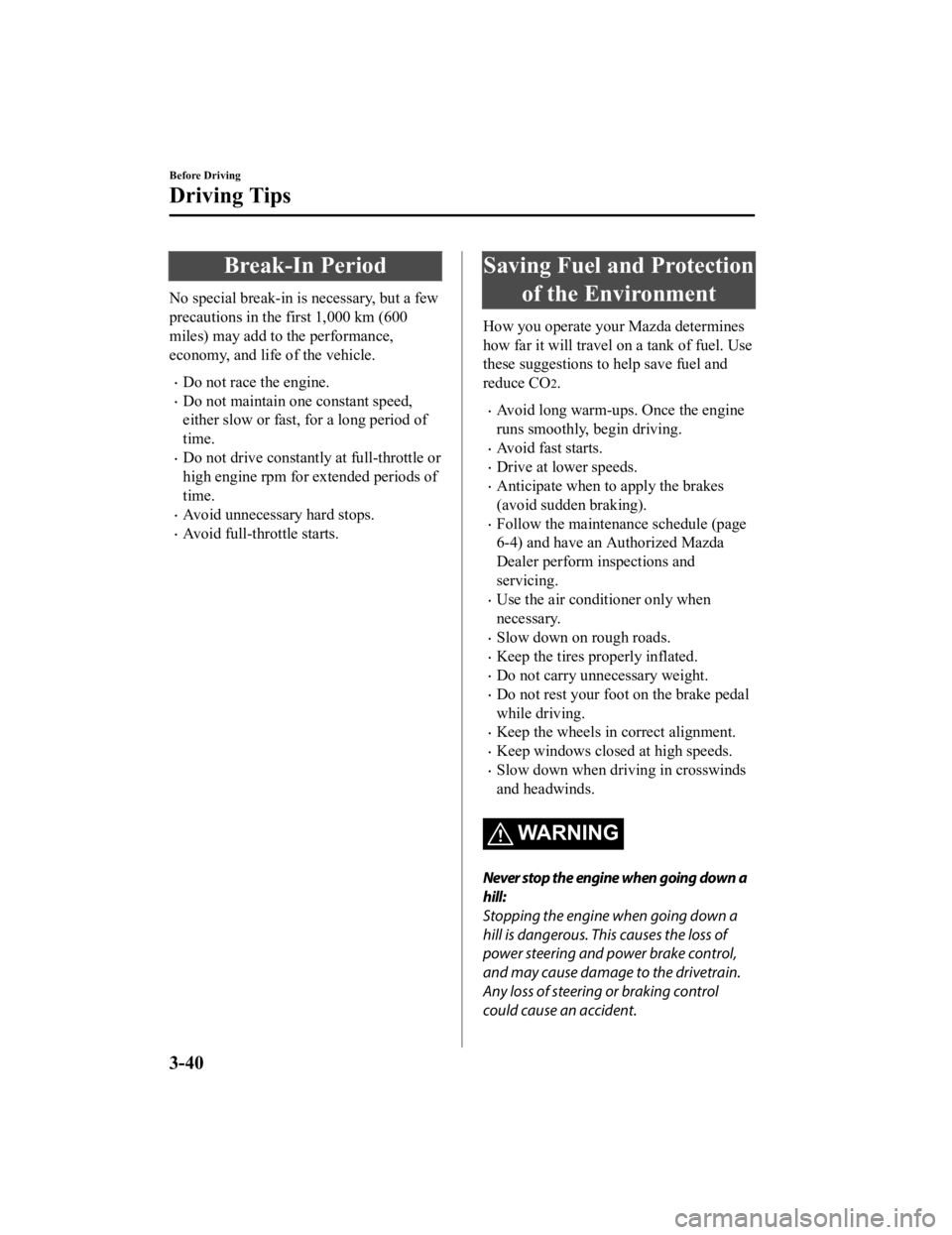Lower control arm MAZDA MODEL CX-3 2021 Owners Manual
[x] Cancel search | Manufacturer: MAZDA, Model Year: 2021, Model line: MODEL CX-3, Model: MAZDA MODEL CX-3 2021Pages: 618, PDF Size: 64.58 MB
Page 105 of 618

Fuel and Engine Exhaust Precautions
▼Fuel Requirements
Vehicles with catalytic converters or oxygen sensors must use ONLY UNLEADED FUEL,
which will reduce exhaust emissions and keep spark plug fouling to a minimum.
To achieve maximum engine performance, use the specified fuel.
Fuel
Octane Rating*1 (Anti-knock index)
Regular unleaded fuel 87 [(R+M)/2 method] or above (91 RON or above)
*1 U.S. federal law requires that octane ratings be posted on gas station pumps.
Fuel with a rating lower than 87 octane (91 R ON) will negatively affect the emission control
system performance and could also cause engine knocking and serious engine damage.
CAUTION
USE ONLY UNLEADED FUEL.
Leaded fuel is harmful to the catalytic co nverter and oxygen sensors and will lead to
deterioration of the emission control system and or failures.
This vehicle can only use oxygenated fuels containing no more than 10 % ethanol by
volume. Damage to the vehicle may occur when ethanol exceeds this recommendation, or
if the gasoline contains any methanol. Stop us ing gasohol of any kind if your vehicle engine
is performing poorly.
Never add fuel system additives other than a Mazda genuine product, otherwise the
emission control system could be damaged. Consult an Authorized Mazda Dealer for
details.
Gasoline blended with oxygenates such as alcohol or ether compounds are generally
referred to as oxygenated fuels. The common gasoline blend that can be used with your
vehicle is ethanol blended at no more than 10 %. Gasoline containing alcohol, such as
ethanol or methanol, may be marketed under the name "Gasohol".
Vehicle damage and drivability problems resulting from the use of the following may not be
covered by the warranty.
Gasohol containing more than 10 % ethanol.
Gasoline or gasohol containing methanol.
Leaded fuel or leaded gasohol.
Before Driving
Fuel and Emission
3-23
CX-3_8JL1-EA-20G_Edition1_old 2020-5-22 15:31:00
Page 122 of 618

Break-In Period
No special break-in is necessary, but a few
precautions in the first 1,000 km (600
miles) may add to the performance,
economy, and life of the vehicle.
Do not race the engine.
Do not maintain one constant speed,
either slow or fast, for a long period of
time.
Do not drive constantly at full-throttle or
high engine rpm for extended periods of
time.
Avoid unnecessary hard stops.
Avoid full-throttle starts.
Saving Fuel and Protectionof the Environment
How you operate your Mazda determines
how far it will travel on a tank of fuel. Use
these suggestions to help save fuel and
reduce CO
2.
Avoid long warm-ups. Once the engine
runs smoothly, begin driving.
Avoid fast starts.
Drive at lower speeds.
Anticipate when to apply the brakes
(avoid sudden braking).
Follow the maintenance schedule (page
6-4) and have an Authorized Mazda
Dealer perform inspections and
servicing.
Use the air conditioner only when
necessary.
Slow down on rough roads.
Keep the tires properly inflated.
Do not carry unnecessary weight.
Do not rest your foot on the brake pedal
while driving.
Keep the wheels in correct alignment.
Keep windows closed at high speeds.
Slow down when driving in crosswinds
and headwinds.
WA R N I N G
Never stop the engine when going down a
hill:
Stopping the engine when going down a
hill is dangerous. This causes the loss of
power steering and power brake control,
and may cause damage to the drivetrain.
Any loss of steering or braking control
could cause an accident.
Before Driving
Driving Tips
3-40
CX-3_8JL1-EA-20G_Edition1_old 2020-5-22 15:31:00
Page 489 of 618

CAUTION
If your Mazda is damaged and needs metal
parts repaired or replaced, make sure the
body shop applies anti-corrosion materials
to all parts, both repaired and new. This
will prevent them from rusting.
▼Bright-Metal Maintenance
Use tar remover to re
move road tar and
insects. Never do this with a knife or
similar tool.
To prevent corrosion on bright-metal
surfaces, apply wax or chrome
preservative and rub it to a high luster.
During cold weather or in coastal areas,
cover bright-metal parts with a coating
of wax or preservative heavier than
usual. It would also help to coat them
with noncorrosive petroleum jelly or
some other protective compound.
CAUTION
Do not use steel wool, abrasive cleaners, or
strong detergents containing highly
alkaline or caustic agents on
chrome-plated or anodized aluminum
parts. This may result in damage to the
protective coating and cause discoloration
or paint deterioration.
▼ Underbody Maintenance
Road chemicals and salt used for ice and
snow removal and solv
ents used for dust
control may collect on the underbody. If
not removed, they wi ll speed up rusting
and deterioration of such underbody parts
as fuel lines, frame, floor pan, and exhaust
system, even though these parts may be
coated with anti-corrosive material.
Thoroughly flush the underbody and
wheel housings with lukewarm or cold
water at the end of each winter. Try also to
do this every month.
Pay special attention to these areas
because they easily hide mud and dirt. It
will do more harm than good to wet
down the road grime without removing
it.
The lower edges of doors, rocker panels,
and frame members have drain holes that
should not be clogged. Water trapped there
will cause rusting.
WA R N I N G
Dry off brakes that have become wet by
driving slowly, releasing the accelerator
pedal and lightly applying the brakes
several times until the brake performance
returns to normal:
Driving with wet brakes is dangerous.
Increased stopping distance or the vehicle
pulling to one side when braking could
result in a serious accident. Light braking
will indicate whether the brakes have been
affected.
▼ Aluminum Wheel Maintenance*
A protective coating is provided over the
aluminum wheels. Special care is needed
to protect this coating.
Maintenance and Care
Appearance Care
*Some models.6-57
CX-3_8JL1-EA-20G_Edition1_old
2020-5-22 15:31:00